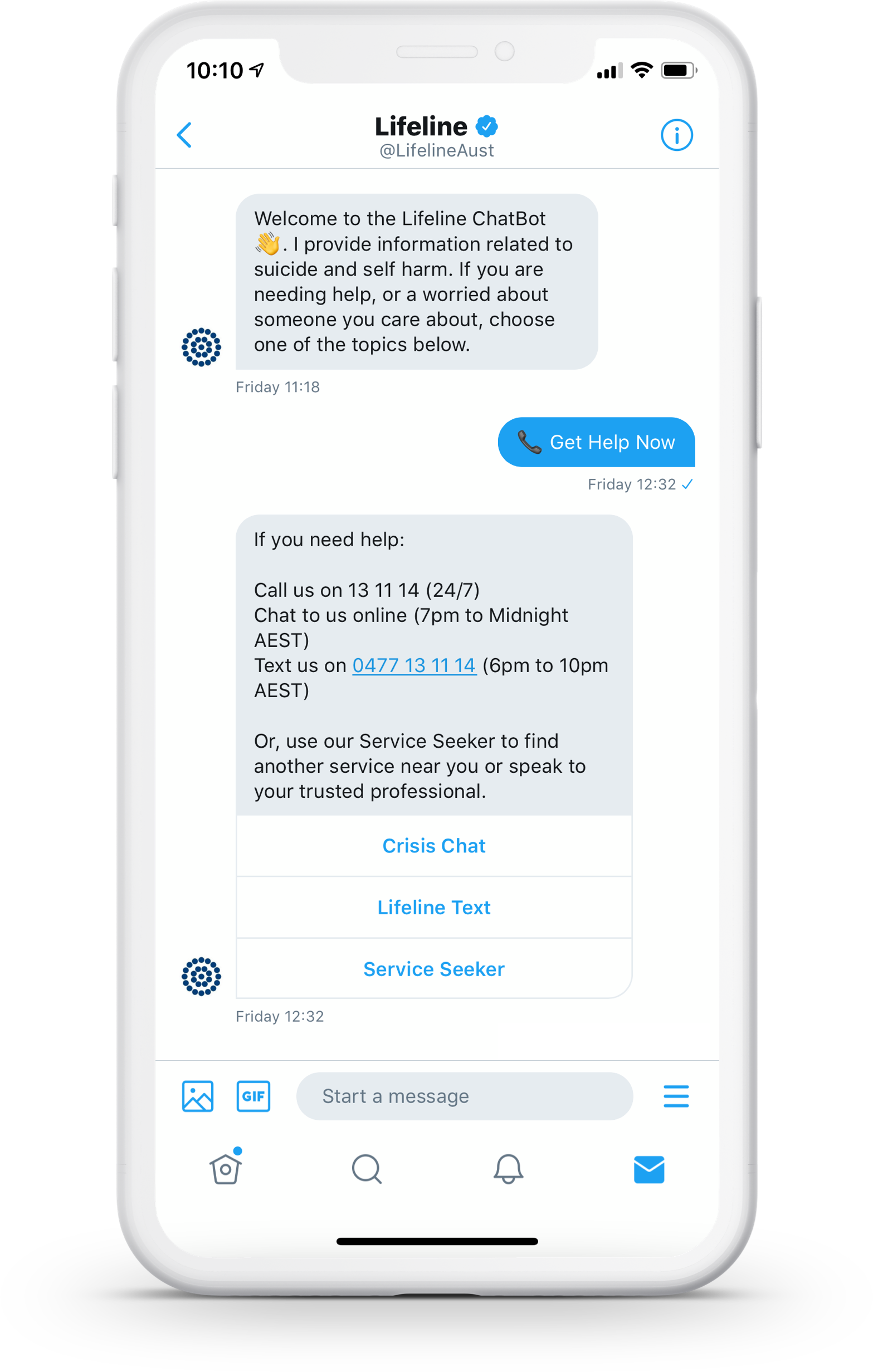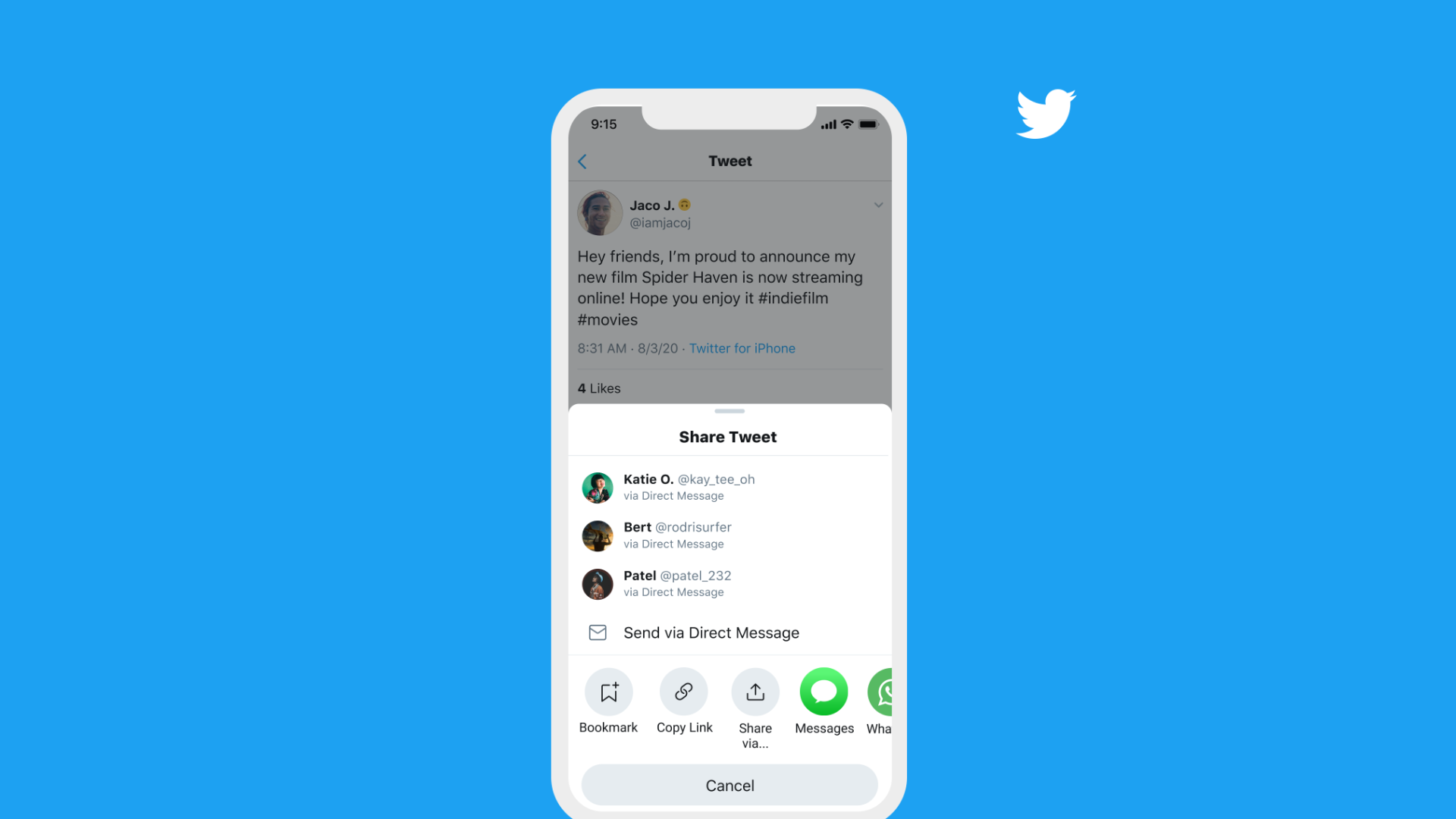Dm Twitter
Twitter has finally added group direct messages (DMs) functionality. A welcome announcement indeed!
The latest tweets from @ayanodm. Direct messages (DMs) let you send your contacts private notes through Twitter. Just like regular tweets and @replies, direct messages are limited to 140 characters. Unlike regular tweets and @replies, the only person who can see a direct message is the recipient. Contents On Twitter, DM is the system that enables private messaging between two users. It is not visible and unknown to other users. Like on a Facebook profile or Facebook page, you can send DMs. We would like to show you a description here but the site won’t allow us. One of the features of the bot is the mass Twitter direct message function. It doesn’t have a limit the same way other Twitter apps do, because it doesn’t use a bulk DM function. Rather, it pulls a list of your followers in and allows you to automate performing one task on all of them.
How it works?
You can start a private conversation with any of your followers who in turn can also invite any of their followers. Here is a handy outline from Twitter’s official announcement:
Key Takeways:
- You can add any follower to the Group DM, who in turn can add any of their own followers (a potential problem – see GroupTweet Advantage #1 below).
- Group DM’s are limited to 50 people.
- Currently, third party developers have no access to Group DM functionality. This means if you use Tweetbot, Hootsuite, or any other non official Twitter client, it may not work for you at all.

I’m optimistic that Twitter’s native Group DM functionality will educate the masses on the possibilities of Twitter Group DM’s which will ultimately lead to “power users” looking to GroupTweet to provide a more “full featured” group DM experience.
How can GroupTweet Improve the Twitter Group DM Experience?
Dm Twitter Mobile
The newly announced native Group DM functionality will work great for more impromptu or ephemeral group DM conversations. However, if you find yourself continually wanting to privately communicate with the same group of individuals on a repeated basis, then you will definitely want to give GroupTweet a try. GroupTweet is the only real way to setup a permanent Group DM conversation channel. For example, you can setup a private GroupTweet Group DM account with your co-workers, classmates, family, etc. Think of it as your own private Twitter based message board instead of having to initiate a new group message thread each time..
What are the Advantages of Permanent GroupTweet Group DM Account?
- Full control over who is included the the Group DM – Twitter’s native functionality allows any group member to invite anyone else into the conversation. With GroupTweet, the group admin(s) have full control over who is allowed in the group, who has posting privileges, and even can limit certain group members to read-only access.
- Granular Access Permissions – With Twitter Group DM’s, anyone in the group can send messages to everyone else in the group. This can lead to “reply-all” spam and annoyance for group members. With GroupTweet, the private group admin can decide exactly which group members can post messages and which group members have read-only access.
- No limit on number of group members – Twitter’s native Group DM limit is 50 people. With GroupTweet, you can add thousands of group members if desired.
- Your GroupTweet Group DM account is permanent (until you delete it if desired) – You don’t have to figure out which new users to add each time you initiate a new Group DM thread. Set it and forget it. Of course, you can always add/remove group members if needed.
- Never lose your messages – Twitter will only display your 100 most recent DM conversations. Meaning old messages can be discarded and lost forever.
- Full search and data export – Twitter offers no search functionality for your Twitter DMs. With GroupTweet you can search and view every old message as well as download/archive all old messages.
- No need for your group members to follow each other – Twitter’s native Group DM functionality requires each group member to either follow each other or be “friends of friends.” With GroupTweet, any Twitter member can decide to join the group if invited/accepted by the group admin. For example, if you setup a GroupTweeet Group DM with a bunch of coworkers or classmates, each member of the group does not need to follow each other. With Twitter’s native Group DM, you have to be a follower of whoever is inviting you into the Group DM.
- You get all the advantages of a full fledged Twitter account – Things like Twitter analytics, GroupTweet contributor analytics (see which members are participating and sending the best Tweets), downloading your full message history, linkable messages.
- Customizable notifications – with Twitter’s native Group DM, you will receive a notification for each and every Group DM you receive. This could get very annoying and overwhelming! With GroupTweet GroupDM you can turn on mobile notifications for specific groups or leave them off and just have the messages appear like normal in your standard home timeline. Additionally, with GroupTweet Group DM, you can simply visit your private group page at anytime to catch up on any messages you missed throughout the day.
- Works with every third party Twitter client – If you try and start a Group DM with your friends that are using Tweetbot, Hootsuite, or any other third party twitter client, they won’t ever receive the message.
- Other GroupTweet only features – Message Moderation (imagine a Teacher wanting to start a Group DM with his/her class but wanting to be able to approve messages before they are sent out) and Smart Scheduling which allows your group messages only to be sent out during pre-defined “Tweeting Hours” as well as spreading out messages throughout the day so you don’t overwhelm your group members with too many Tweets in a short period of time.
Want to Give a GroupTweet Group DM account a Spin?
We’ve created a demo GroupTweet group DM account for you to test and see how it works. Simply follow the instructions here to try it out with our demo account: GroupTweet.com/GroupDM. You simply send a Twitter DM to the @GroupDMdemo account and then it will be privately Tweeted to all approved followers of that private account.
Ready to create your own private GroupTweet Group DM account? Follow the detailed step by step instructions here.
Any Questions or Feedback?
How could GroupTweet improve the Twitter Group DM experience for you?
GroupTweet Group DM accounts can be used in so many different ways. Its a flexible tool that can be used both privately and publicly (if desired). Don’t hesitate to ask a questions in the comments below or you can email groupdm@grouptweet.com with any other questions!
Hi, I'm Ryan Craft, Co-Founder of GroupTweet.com. GroupTweet allows you to add multiple contributors to a single Twitter account - creating a seamless group Twitter experience. Want to learn more? Click here for some examples or reach out via Twitter, you can find me @craft_ryan
-->Omnichannel for Customer Service offers a suite of capabilities that extend the power of Dynamics 365 Customer Service Enterprise to enable organizations to instantly connect and engage with their customers across digital messaging channels. An additional license is required to access Omnichannel for Customer service. For more information, see the Dynamics 365 Customer Service pricing overview and Dynamics 365 Customer Service pricing plan pages.
Many customers use social messaging channels like Twitter Direct Message for their personal communication needs. Many also prefer using these messaging channels to engage with businesses. The asynchronous nature of these channels gives customers the convenience of getting their issues resolved as and when they find time, unlike real-time channels like Chat for Dynamics 365, where the session ends when the chat window is closed.
The Twitter channel gives you an incredible opportunity to capitalize on the social media trend and engage with your customers in a seamless and personalized experience.
Prerequisites
The following are important prerequisites that you must complete before configuring the Twitter channel in Omnichannel for Customer Service.
Note
To enable the Twitter channel in an existing Omnichannel for Customer Service environment, you must upgrade to the latest version of Omnichannel for Customer Service.
- Create a Twitter handle. More information: Create and Manage a Twitter business profile
- Enable Direct Message for your Twitter handle. More information: Enable Direct Message
- Create a Twitter application. Apply for a developer account, not a team account. Create a Twitter developer environment. More information: App Development
- Update the Twitter application permissions to read, write, and access Direct Messages. More information: App permissions
After completing the prerequisites, you can add the Twitter channel for your organization by following these steps:
- Create a Twitter channel and add a Twitter handle.
- Create routing rules.
Create a Twitter channel and add a Twitter handle in Omnichannel admin center
- In the site map, select Channels under General settings, and on the Accounts and channels page, select Add account.
- Enter the following details:
On the Channel details page, enter a name and select Twitter.
On the Account details page, enter the following details:
- Consumer API key: Key of the Twitter application. Go to the Twitter developer portal > Twitter app dashboard > Details > Keys and tokens, and then copy the value in the API key field.
- Consumer API secret: Application secret of the Twitter application. Go to the Twitter developer portal > Twitter app dashboard > Details > Keys and tokens, and then copy the value in the API secret key field.
- Environment name: Environment of the Twitter application. Go to the Twitter developer portal > Dev environments > Dev environment label (make sure that the dev environment was created under Account Activity API).
Important
The Environment name field cannot be a random string and must match the Dev environment label in the Twitter developer portal.
On the Callback information page, copy the text in the Callback URL box. You'll use the copied information in the Twitter account.
Select Done.
- To configure routing and work distribution, you can create a workstream or select an existing one.
- Select the workstream that you've created for the Twitter channel and on the workstream page, select Set up Twitter, and configure the following options:
- On the Twitter handle page, select a handle from Available Twitter handles.
- On the Language page, select a language.
- On the Behaviors page, configure the following options:
- On the User features page, set the toggle for File attachments to On and select the following checkboxes if you want to allow agents and customers to send and receive file attachments. More information: Enable file attachments.
- Customers can send file attachments
- Agents can send file attachments
- Verify the settings on the Summary page, and select Finish. The Twitter channel instance is configured.
- Configure routing rules. More information: Configure work classification.
- Configure work distribution. More information: Work distribution settings
- Add a bot. More information Configure a bot.
- In Advanced settings, configure the following options based on your business needs:
Create a Twitter channel and add a Twitter handle in Omnichannel Administration
Note
Before starting this procedure, you must meet the prerequisites described earlier in this topic.

Go to Channels > Twitter.
Select New to create a Twitter channel.
On the New Twitter Application page, provide the following account details:
Name: Name of the Twitter application.
Consumer API key: Key of the Twitter application. Go to the Twitter developer portal > Twitter app dashboard > Details > Keys and tokens, and then copy the value in the API key field.
Consumer API Secret: Application secret of the Twitter application. Go to the Twitter developer portal > Twitter app dashboard > Details > Keys and tokens, and then copy the value in the API secret key field.
Environment name: Environment of the Twitter application. Go to the Twitter developer portal > Dev environments > Dev environment label (make sure that the dev environment was created under Account Activity API).
Important
The Environment name field cannot be a random string and must match the Dev environment label in the Twitter developer portal.
More information about the Twitter app: Setting up your Twitter app
Select Save. After you save the record, the Twitter channel is enabled. The Callback URL has been generated. The next step is to save it.
To save the Callback URL in the Twitter app dashboard of the developer portal, go to the Twitter developer portal > Twitter app dashboard > Details > App details > Edit. Copy the Callback URL from Omnichannel for Customer Service, and then paste it into the Callback URLs field.
Add a Twitter handle: In the Twitter app section, select New Twitter handle to add Twitter handles.
On the New Twitter handle page, provide the following information:
- Name: Not the Twitter handle, but a name that you can reference.
Select Sign on to Twitter. A pop-up window appears. Sign in by using the Twitter handle and password that will be added here.
Note
If you receive a message that says pop-up windows are blocked, select to always allow them.
On the General settings tab, provide the following information:
Language: Select the preferred language for your Facebook page.
Work Stream: Select the out-of-the-box work stream for the Twitter channel. To create a work stream, see Create work streams.
Enable file attachments for customers: Set to Yes to allow customers to send file attachments to agents. Otherwise, set No.
Enable file attachments for agents: Set to Yes to allow agents to send file attachments to customers. When the agent sends an attachment, the app uploads the attachment to Twitter and captures the media ID. Otherwise, set No.
To learn more about attachments, see File attachments.
To learn more about uploading media in Twitter, see Twitter developer documentation.
On the Automated messages tab, configure automated messages.
On the Surveys tab, configure a post-conversation survey.
Select Save to save the record. The Twitter channel setup is complete.
Note
You can add multiple handles to a Twitter Application channel.
Create routing rules in Omnichannel Administration
- Go to Work Distribution Management > Work Streams.
- Open the out-of-the-box work stream or the one you created.
- On the Routing rules items tab, create a routing rule to transfer the message to an appropriate agent. Select the entity as Twitter Engagement Context. For example, you can create a rule to transfer Twitter chat from a customer named Twitter to the default queue.
When you create conditions for routing rules, the Twitter Engagement Context (Conversation) entity enables you to set the following attributes:

- Customer name
- Customer screen name
- Followers count
- Friends count
Customer and agent experiences
A customer can initiate a conversation in any of the following ways:
Dm Twitter Abbreviation
- Twitter app on a mobile device
- Twitter app on a desktop device
If a customer initiates a conversation from the Twitter website and then later switches to the mobile device, the previous conversation persists and the customer can continue the conversation.
The agent receives the notification of the incoming chat request, along with customer details. More information: View notifications
Once the Twitter social profile is linked to an user customer/contact record by the agent, subsequent Twitter conversations are linked to the customer records and the customer summary is populated.
If the customer isn't identified by name, a new contact record can be created.
Privacy notice
By enabling this feature, your data will be shared with Twitter and flow outside of your organization's compliance and geo boundaries (even if your organization is in a Government Cloud environment). Please consult the feature technical documentation for more information here.
Dm Twitter Abbreviation
Customers are solely responsible for using Dynamics 365, this feature, and any associated feature or service in compliance with all applicable laws, such as laws relating to monitoring, recording, and storing communications with their end-users. This includes adequately notifying end-users that their communications with agents may be monitored, recorded, or stored and, as required by applicable laws, obtaining consent from end-users before using the feature with them. Customers are also encouraged to have a mechanism in place to inform their agents that their communications with end users may be monitored, recorded, or stored.
See also
Understand and create work streams
Configure automated messages
Configure a post-conversation survey
Create and manage routing rules
Delete a configured channel
Note
Can you tell us about your documentation language preferences? Take a short survey.
The survey will take about seven minutes. No personal data is collected (privacy statement).
